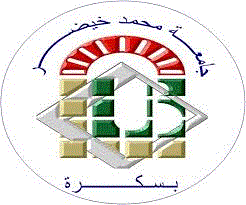| Titre : | Développement d’un système d’aide au diagnostic médical en utilisant les ontologies floues |
| Auteurs : | CHAIMA ZIAD, Auteur ; Nadia Ben Seghier, Directeur de thèse |
| Type de document : | Monographie imprimée |
| Editeur : | Biskra [Algérie] : Faculté des Sciences Exactes et des Sciences de la Nature et de la Vie, Université Mohamed Khider, 2021 |
| Format : | 1 vol. (63 p.) / ill. / 29 cm |
| Langues: | Français |
| Mots-clés: | Ontologie floue, Logique floue, Analyse médicale. |
| Résumé : | Afin de construire un système de diagnostic médical robuste capable de connaître la bonne maladie entre de nombreuses maladies présentant des symptômes similaires, dans ce travail, nous avons créé une ontologie floue basée sur la logique floue pour traiter les inexactitudes et les incertitudes qui caractérisent certains concepts et relations, où le rôle derrière cela est d'assister notre système. Nous avons créé un programme Java pour gérer cette ontologie en tant que base de connaissances pour ce programme et pour l'utiliser de manière simple également. |
| Sommaire : |
General introduction ..........................................................................................1
Chapter I: the ontologies2 1 Introduction ..............................................................................................3 2 The definition of ontologies .........................................................................................3 2.1 From philosophy ........................................................................................................3 2.2 History ..........................................................................................................3 2.3 Definition ......................................................................................................4 3 The usefulness of ontologies ........................................................................................5 4 Components of Ontology .............................................................................................5 5 Ontology Evaluation .....................................................................................................5 5.1 Verification ................................................................................................................5 5.2 Validation ..................................................................................................................6 5.3 Evaluation by Criteria ................................................................................................6 6 Types and Examples of Ontologies ..............................................................................7 6 .1 Types of ontologies ..................................................................................................7 6 .2 Examples of ontologies ............................................................................................8 7 Ontological Engineering ...............................................................................................8 7.1 Identification of Objectives and Context ...................................................................8 7.2 Construction of Ontology ..........................................................................................9 7.2.1 Capture of Ontology: Independent of a language of "Conceptualization" .............9 7.2.2 Coding of Ontology: "Explicit representation of the Conceptualization" .............9 7.2.3 Integration of Existing Ontologies ........................................................................9 7.3 Assessment ................................................................................................................9 7.4 Documentation ..........................................................................................................9 8 Conclusion ....................................................................................................................9 Chapter II: Fuzzy Logic ..................................................................................................10 1 Introduction ................................................................................................................11 2 Fuzzy logic definition .................................................................................................11 3 uzzy sets ....................................................................................................................12 4 Fuzzy Logic Architecture ............................................................................................13 4.1 Rule base ...................................................................................................................13 4.2 Fuzzification ..............................................................................................................13 4.3 Inference Engine ........................................................................................................13 4.4 Defuzzification .........................................................................................................13. 5 Advantages and Disadvantages of Fuzzy Logic in Artificial Intelligence ...................14 6 Implementation ...........................................................................................................14 6.1 When can fuzzy rule bases be used ..........................................................................14 6.2 Designing an application .........................................................................................15 6.2.1 Choice of operators .................................................................................................15 6.2.2 Methodology ..........................................................................................................15 6.2.3 Collecting knowledge ............................................................................................15 6.2.4 Validating the knowledge base ...............................................................................15 6.2.5 Tuning .....................................................................................................................16 6.3 Using an application .................................................................................................16 6.3.1 The function of the operators ..................................................................................16 6.3.2 Production changes .................................................................................................16 6.4 Choosing the implementation technology ...............................................................17 6.5 Standards ..................................................................................................................17 6.5.1 Components ............................................................................................................17 6.5.2 Software .................................................................................................................17 7 Applications of Fuzzy Logic .......................................................................................18 8 Conclusion ..................................................................................................................18 Chapter III: Fuzzy Ontologies .......................................................................................19 1 Introduction .....................................................................................................20 2 The definition of Fuzzy Ontology ................................................................................20 3 Why Fuzzy Ontology Is Needed ..................................................................................22 4 How Fuzzy Ontology Is Represented ...........................................................................22 5 Fuzzy Ontologies Formal Description ..........................................................................23 6 Conclusion .....................................................................................................24 Chapter IV: The Proposed Medical Diagnostic Help System Using Fuzzy Ontologies ..........................................25 1 Introduction ...................................................................................................................26 2 Choice of the construction method of our ontology .....................................................26 3 Stages of the construction process of our ontology .....................................................26 3.1 Needs assessment .....................................................................................................26 3.1.1 Use case diagram ...................................................................................................28 3.1.2 Add patient sequence diagram ...............................................................................28 3.1.3 Class diagram .........................................................................................................29 3.2 Conceptualization .....................................................................................................29 3.2.1 Construction of the glossary of terms .....................................................................30 3.2.2 Construction of the taxonomy of concepts .............................................................30 3.2.3 Construction of the dictionary of precise concepts ...............................................31 3.2.4 Construction of the table of binary relations (Précised) ........................................32 3.2.5 Construction of the instance attributes table ..........................................................33 3.2.6 Construction of the table of class attributes ..........................................................33 3.2.7 Table of instances of précised concepts ................................................................34 3.2.8 Table of fuzzy assertions .......................................................................................34 3.2.9 Construction of the fuzzy part ................................................................................34 3.3 Formalization ............................................................................................................35 3.3.1 Representation of the terminology part (T-Box) ....................................................36 3.3.1.1 Definition of concepts .........................................................................................36 3.3.1.2 Definition of relations ..........................................................................................36 3.3.1.3 Inclusion of concepts ...........................................................................................36 3.3.2 Representation of the assertional part (A-Box) ....................................................37 4 Conclusion ....................................................................................................................37 Chapter V: The Implementation ....................................................................................38 1 Introduction ..................................................................................................................39 2 The Used Programming Tools ......................................................................................39 2.1 Protégé ......................................................................................................39 2.1.1 Definition ................................................................................................................39 2.1.2 Installation Process ................................................................................................39 2.2 Fuzzy Owl2 Pluging ..................................................................................................40 2.2.1 Definition ...............................................................................................................40 2.2.2 Installation Process ................................................................................................40 2.3 Fuzzy DL Reasoner ..................................................................................................41 2.4 Eclipse ......................................................................................................................42 2.4.1 Definition ...............................................................................................................42 2.4.2 Installation Process ................................................................................................42 2.5 OWL ..........................................................................................................................42 2.6 Java ......................................................................................................................42 3 The implementation Process ........................................................................................43 4 The verification ............................................................................................................45 5 Application’s GUIs .....................................................................................................46 6 Conclusion ...................................................................................................................49 General Conclusion .........................................................................................................50 Bibliography .....................................................................................................................51 Annex .......................................................................................................................53 |
| Type de document : | Mémoire master |
Disponibilité (1)
| Cote | Support | Localisation | Statut |
|---|---|---|---|
| MINF/628 | Mémoire master | bibliothèque sciences exactes | Consultable |





